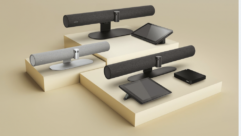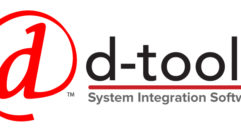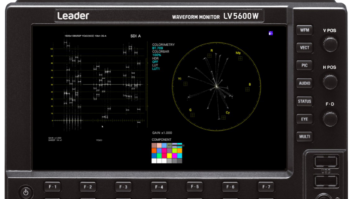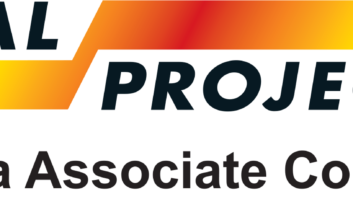
Beyerdynamic MCW-D 50
Jan 1, 2007 12:00 PM,
By John McJunkin
Conferencing system facilitates clear, secure communication.

The brochure for the Beyerdynamic MCW-D 50 emphasizes clarity as a crucial priority in conveying information verbally in congresses, seminars, or conferences. A true statement, certainly, but in 2007, the ability to capture conversations and securely transmit or archive them also ranks high on the priority list. As I learned when I had the opportunity to spend time with the MCW-D 50 recently, this conferencing system performs both vital functions effectively.
First, an overview of the system components: The central control unit for the system, the MCW-D 50, can be combined with a number of wireless remote microphones. The particular system I examined featured one MCW-D 523 chairman microphone unit and three MCW-D 521 delegate units. The entire system shipped in a CC 10 modular case. This case on casters is not just for transportation or storage of the control unit and up to 10 microphones, however; it also has a clever built-in charging unit to keep the microphones’ batteries charged for use. Another clever feature: The charge status of those microphones is indicated by LED rings on each unit, which can be conveniently observed through a clear Plexiglas window on the side of the case, even with the lid in place. I found this setup very functional indeed.
There are two versions of the MCW-D 50 control unit, one with a single RF module, the other with three, for use with three or nine microphones, respectively.
The front panel of the MCW-D 50 is simple — even downright spartan. From left to right, there are a power-indicator LED, a standby button, nine LEDs to indicate channel status (green indicates “vacant” and red indicates “occupied”), and a knob that controls the volume of the speakers in the microphone units. The rear panel features RS-232 and LAN network connections, stereo RCA inputs and outputs with level controls, balanced XLR input and output, and coaxial antenna connectors (two for receive, one for transmit), as well as a power switch, fuse receptacle, and IEC main power input.
The system operates in a number of modes. FIFO mode is used to handle more simultaneously open microphones than the system is nominally configured for. In FIFO mode, the first mic switched on is the first switched off when a different mic, exceeding the total limit, is switched on. Push-to-talk mode requires holding the microphone button for the duration of an individual’s comments. Voice activation mode opens the microphone with a gate, the threshold of which is set with the system’s software.
I found the microphone units simple in form and operation as well. The more complex of the two types is, of course, the MCW-D 523 chairman unit, which is placed in front of the person leading the discussion. It features three buttons — one to turn on the microphone, one to clear the delegate units, and one “soft” button, the function of which is determined by the user. Aside from these buttons, the front panel also features a gooseneck microphone and a small speaker. The rear panel features contacts through which the batteries are charged, a DC power input for charging and/or DC operation, an LED indicating the status of the unit, and a stereo jack for connecting either a recording device or headphones.
The MCW-D 521 delegate microphone unit is virtually identical to the chairman unit — the only distinction is that it has only one button, with which the user can activate the microphone or request to be recognized.
SOFTWARE CONTROL
Software included with the system provides control over a multitude of functions. For instance, frequency bands can be selected under the RF Settings header, and individual modules can be enabled or disabled. The RF Monitor visual display makes this a particularly useful function by indicating the amount of RF interference in each band, which allows users to choose the range with the least interference in any given setting.
The software also has a handy meeting time function to track the length of the meeting. Participants’ names can be entered and managed via computer, simplifying operation of the graphical user interface by the chairman. In addition, the function button of the chairman’s unit can be programmed to perform various clearing and muting functions, as well as to trigger an event (lighting, lowering of a projection screen, start of a presentation, and so forth).
The Controller software, the primary application by which the chairman operates the conferencing system, provides a visual display of the status of each microphone unit, with icons indicating idle, requesting, speaking, talk time expired, and battery status. The speaking (and warning) time for each microphone can be set with the software, activating a timer that flashes individual microphone units’ LEDs shortly prior to the expiration of time, and then lights them continuously when time is up. The microphone units can even be programmed to turn off when time expires. Configurations of the entire system can be stored and recalled, making the system easily portable for use in different locations and scenarios.
The computer also provides sophisticated audio control, including mic attenuation, which automatically lowers mic levels as more open mics come online, helping to avoid feedback. Mixing functions are enabled, as well, allowing the auxiliary inputs to be combined with the mics. Users can also switch teleconferencing mode on and off via the software.
Another computer-controlled function is security, a feature highly touted by Beyerdynamic, and rightly so, in a time when corporate or governmental espionage are very real issues. A PIN code set in the system’s software can encode the transmission to prevent unauthorized access.
FINAL EVALUATION
The Beyerdynamic MCW-D 50 system is a cleverly designed and easily used solution. The system substantially clarifies communication in teleconferencing and recording, and does so with great simplicity. I test-drove the system in a large room to verify its capability to enhance clarity, and it is substantial. I had no difficulty setting up the system, its connections, nor its configuration. It is simple to understand and powerful to use — truly excellent, and a great solution for any organization that requires solid, secure communications in meeting or debate settings.
PRODUCT SUMMARY
Company: Beyerdynamic
www.beyerdynamic.com
Pros: Very solid construction and operation, easy to use.
Cons: None to speak of.
Applications: Intended for organizations that need clear, secure communications and/or recording for meetings.
Price: MCW-D 50-3: $4,499; MCW-D 523 chairman station: $1,149; MCW-D 521 delegate stations: $999 per station; CC 10 charging and transport case: $1,999; system as tested: $10,644
SPECIFICATIONS
MCW-D 523/521 microphone units
Frequency range: 2400MHz to 2483.5MHz (ISM-band)
Signal-to-noise ratio: 80dB typical (unweighted)
Range (microphone to control unit): >300ft.
Output level: Maximum 2.3Vrms at 600Ω load, THD <1%
Minimum impedance: 600Ω
Limiter activity at: 126dB SPL
Dimensions (without microphone): 7.5″×6.2″×2″ (L×W×H)
Weight: 3.8lbs.
MCW-D 50 control unit
Frequency response: 70Hz to 10kHz (-3dB)
Master output (balanced): XLR, +6dBu
Master output (unbalanced): RCA, level adjustable (1.55V-300mV range)
Input (balanced): XLR, +6dBu, switchable
Input (unbalanced): RCA, +15dBu, -10dBu, switchable
Dimensions (W×H×D): 2RU (17.3″×3.5″×12.2″)
Weight: 10.4lbs.
John McJunkinis the principal of Avalon Podcasting in Chandler, Ariz. He has consulted in the development of studios and installations and provides high-quality podcast production services.










